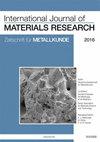Facile synthesis of Ag2ZrO3 nanocrystals with highly enhanced visible-light photocatalytic activity
IF 0.7
4区 材料科学
Q4 METALLURGY & METALLURGICAL ENGINEERING
引用次数: 0
Abstract
This paper describes the synthesis of Ag2ZrO3 nanocrystals using coprecipitation and microwave-assisted hydrothermal methods. These nanocrystals were characterized by means of X-ray diffraction, micro-Raman spectroscopy, Fourier transform infrared absorption spectroscopy, field emission scanning electron microscopy, and UV–Visible spectroscopy, and their photocatalytic performance for methylene blue degradation under visible-light irradiation has been tested. The X-ray diffraction, micro-Raman spectroscopy, Fourier transform infrared absorption spectroscopy analyses indicate that the Ag2ZrO3 nanocrystals have good crystallinity and no secondary phases. The UV–Visible spectroscopy results showed a variation in the optical band gap values (2.71–2.97 eV) with increasing temperature, which indicates the possible presence of defects in the crystal lattice at a medium range. Field emission scanning electron microscopy images revealed that the nanocrystals have uneven spherical shapes and average particle size around 50–70 nm. The good photocatalytic efficiency can be attributed to defects in the silver zirconate structure capable of forming the active adsorption sites. Finally, we discuss a photocatalytic mechanism to understand the photocatalytic process in cationic dye (methylene blue) degradation in aqueous solution.简便合成具有高度增强可见光光催化活性的 Ag2ZrO3 纳米晶体
本文介绍了利用共沉淀和微波辅助水热法合成 Ag2ZrO3 纳米晶体的方法。通过 X 射线衍射、显微拉曼光谱、傅立叶变换红外吸收光谱、场发射扫描电子显微镜和紫外可见光谱对这些纳米晶体进行了表征,并测试了它们在可见光照射下降解亚甲基蓝的光催化性能。X 射线衍射、显微拉曼光谱和傅立叶变换红外吸收光谱分析表明,Ag2ZrO3 纳米晶体具有良好的结晶性,且不存在次生相。紫外-可见光谱结果显示,光带隙值(2.71-2.97 eV)随温度升高而变化,这表明晶格中可能存在中等范围的缺陷。场发射扫描电子显微镜图像显示,纳米晶体呈凹凸不平的球形,平均粒径约为 50-70 纳米。良好的光催化效率可归因于锆酸银结构中能够形成活性吸附位点的缺陷。最后,我们讨论了光催化机理,以了解阳离子染料(亚甲基蓝)在水溶液中的光催化降解过程。
本文章由计算机程序翻译,如有差异,请以英文原文为准。
求助全文
约1分钟内获得全文
求助全文
来源期刊
CiteScore
1.30
自引率
12.50%
发文量
119
审稿时长
6.4 months
期刊介绍:
The International Journal of Materials Research (IJMR) publishes original high quality experimental and theoretical papers and reviews on basic and applied research in the field of materials science and engineering, with focus on synthesis, processing, constitution, and properties of all classes of materials. Particular emphasis is placed on microstructural design, phase relations, computational thermodynamics, and kinetics at the nano to macro scale. Contributions may also focus on progress in advanced characterization techniques. All articles are subject to thorough, independent peer review.

 求助内容:
求助内容: 应助结果提醒方式:
应助结果提醒方式:


